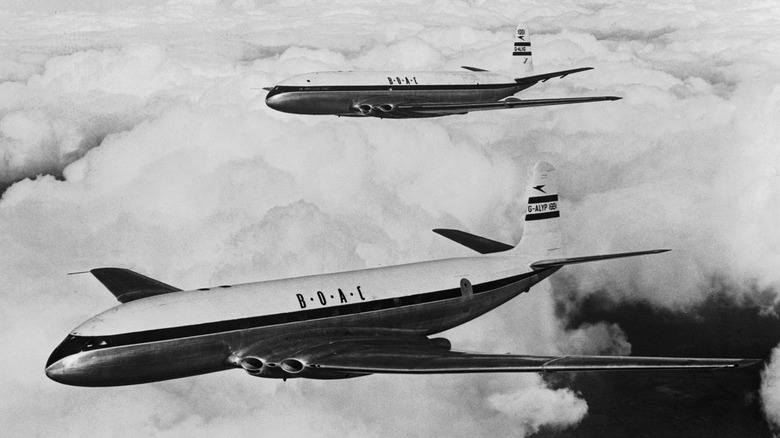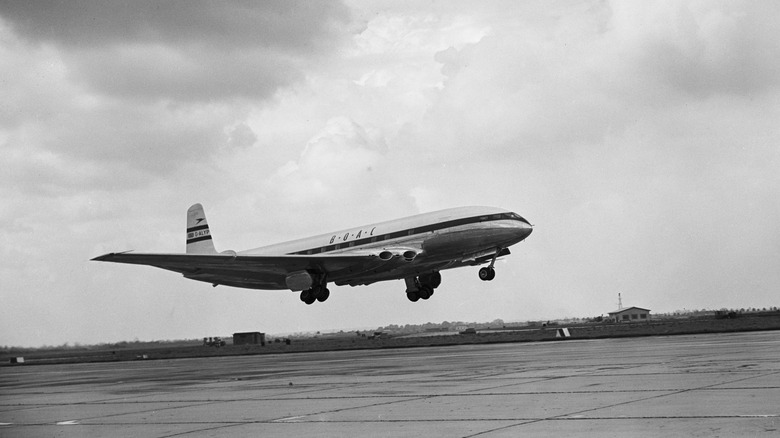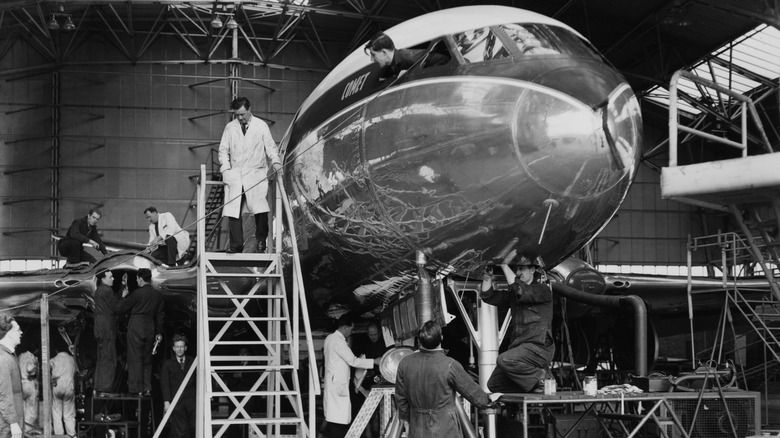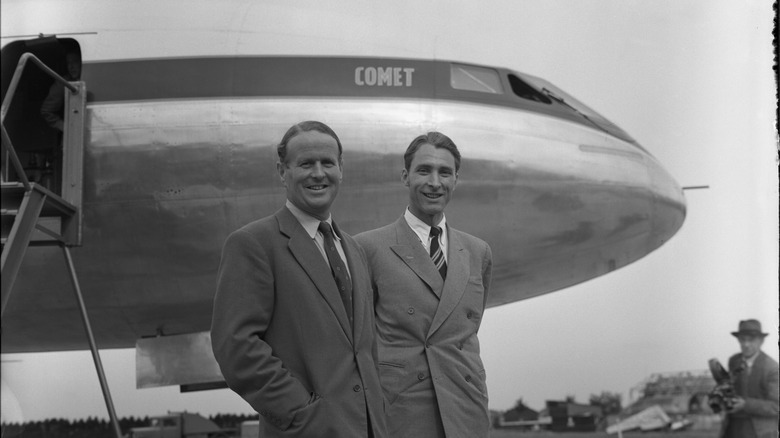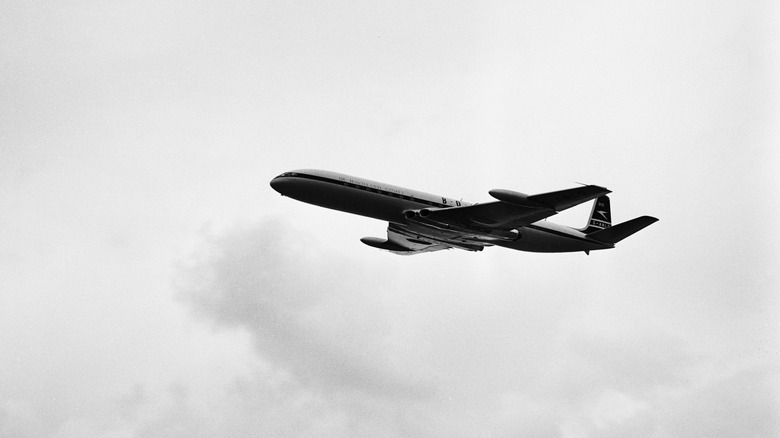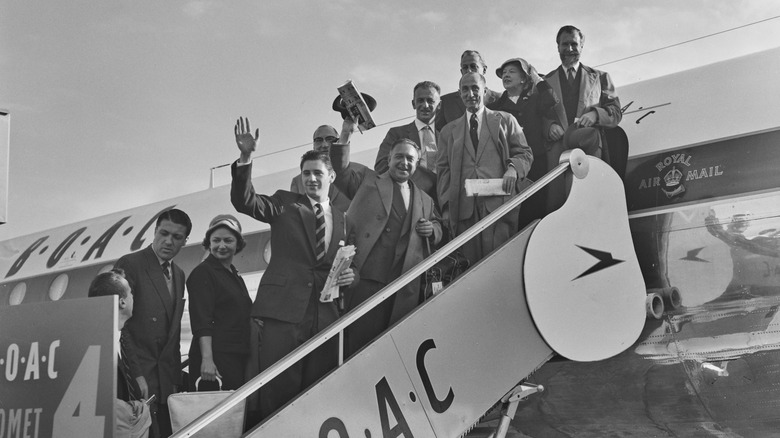All About The De Havilland DH.106 Comet Jet
Many of today's most iconic aircraft bear the names of those aviation visionaries who were instrumental in bringing them into being. The lightning-fast Sukhoi Su-57, for instance, was developed by the company originally known as the Sukhoi Design Bureau – the 1939 creation of one Pavel Sukhoi. The De Havilland Aircraft Company, meanwhile, was founded around two decades earlier in London by the British Geoffrey de Havilland, who had studied and worked at the Crystal Palace School of Engineering and Wolseley Tool and Motor Car Company, before setting about designing an aircraft alongside his friend, Frank Hearle.
From these humble, 'amateur' beginnings (de Havilland's grandfather lent him the money needed for the project), de Havilland's aviation empire would grow to be enormously influential. Among the aircraft that bore and continue to bear his name, is the Mosquito B.Mk.35 bomber — a supercharged model that could be equipped with a 4,000 lb bomb – developed during World War II. The company also developed the DH.106 Comet, a revolutionary model in its time, and what is considered to be the world's first glimpse of an airliner with a jet engine.
Let's take an in-depth look at how de Havilland brought jet technology to the then-growing world of commercial flight, how the Comet was built and iterated upon as time went on, its performance, and its position in the industry.
De Havilland seeks a new type of machine to break into the airliner market
The Heinkel He 178 — the very first aircraft with a jet engine – made its inaugural flight in late August 1939, just days before the outbreak of World War II. Capable of flying for only 10 minutes, the great speed it could achieve (375 mph) was tempered by the fact that it was essentially unusable. Over the course of the conflict, both sides strove to harness the capabilities of this new technology. Speed, power, and efficiency in turbojet technology could translate to great advantages for the air force that wielded them, after all.
This line of thinking led to the development of such formidable jets as 1942's Messerschmitt Me 262, suggesting that jet engines could indeed mark the future of military aircraft. de Havilland, however, would be instrumental in seeing the potential of jets beyond the combat sphere, and how well they might perform in the civilian travel industry.
Though de Havilland would develop some successful military aircraft (7,780 of the aforementioned Mosquito were manufactured), one of the company's better-known and most innovative jets was designed for a very different purpose. The Comet would be an industry first as a passenger jet.
The concept and objectives of the Comet take shape
In any industry, the driving force of true advancement and change is creativity, and the boldness to try new things. de Havilland, prior to the introduction of the Comet, had certainly demonstrated its willingness to depart from the status quo and take risks. The Mosquito, dubbed the "Wooden Wonder" for risking a wooden body in a resolutely metal-aircraft world, had made that very clear. Despite the rise of post-war jet engines, it was very much the attitude that airliners would stick with their comfortable propellers.
de Havilland, however, wanted to overturn this convention with the Comet. The United Kingdom's Brabazon Committee was created in 1942, with the intent of establishing a way for the country to position itself as a powerhouse in the emerging commercial flight world. Its conclusion was that an airliner capable of ferrying mail across the Atlantic in 400 mph flight, at 40,000 feet, would have the utility to do just that.
Could an aircraft with a jet engine achieve all this? The industry doubted that, but de Havilland was very keen to prove them wrong. It would get the opportunity to try to do just that in February 1945, when it was contracted to create the Type 106, eventually to be known as the Comet jet. As there had never been an aircraft quite like it, its development was a complex and dangerous process.
The timeline and process of the Comet jet's complex design
In September 1946, the Comet concept began to be put together. It was almost three full years later that the machine made its maiden flight, but to skip ahead to the end in that way is to discount the journey it went through from concept to completed prototype.
R. E. Bishop, Chief Designer of the new aircraft, described the process in great detail in a piece for Key.Aero. Bishop explained that to build upon the existing airliners of the United States, such as the Douglas DC-6, would be counter to the objectives of the project and result in a model that was outdated before it reached wider use. To avoid that, an aircraft that was all the more original, yet practical and not overly "out there" so as to demand parts that could be temperamental or difficult to acquire, was called for.
"The more we studied the problem the more confident we became that a full-size airliner for about 40 passengers was justifiable," Bishop wrote. What would form the basis of the design of the aircraft these 40 hypothetical passengers would travel in? The virtues of unusual decisions like dispensing with the aircraft's tail were discussed, but finally rejected. The 93-foot-long DH 106 Comet that would ultimately fly was sleek and aerodynamic, of course, but the exterior didn't really depart from the image of a classic airliner. Inside, though, things were rather more interesting.
The Comet's specs, performance, and flight experience
For airliners today, passenger volume (and so profitability of flights) is often considered the top concern. The Comet's design, however, seemed to favor the comfort of passengers. With large, reclining seats for 36 people (44 being the Comet's maximum passenger capacity), the modestly-sized aircraft (Douglas' DC6B was almost 108 feet long) spaced everybody out enough that the interior may have seemed rather bigger than it was.
Offering varied food service and seating areas with tables, the British Overseas Airways Corporation debuted the production Comet in May of 1952. The following month, a flight for such lofty guests as Queen Elizabeth II and the Queen Mother seemed intended to emphasize that commercial flight could be a splendid, sophisticated, and social affair, as well as a simple means of transportation.
Glamorous appearances would be nothing, though, if the airliner couldn't also demonstrate the virtues of the jet engine and thereby justify its own existence. Powered by a quartet of DH Ghost 50 engines, the original Comet had a range of 1,500 miles and could hit 460 mph, allowing it to reach Tokyo from London in a relatively meager 36 hours rather than three and a half days. Grueling journeys became much less so, and the world became a much more traversable place. Improved and more popular airliners in the Comet family would follow, though the family's time in the spotlight would be marred by tragedy too.
The highs and lows of the Comet's legacy
Here's the most difficult part of being the first of anything: However cautious you are, there's going to be an element of the unknown about proceedings. The Comet would enjoy great success, being embraced by such varied airlines as East African Airways, Aerolineas Argentinas, and United Arab Airlines by the time of the Comet 4's introduction (beginning in 1958), but its history was struck by calamity too. In 1954, the Royal Aircraft Establishment started an enormous crash test investigation into the in-flight destruction of two Comets during flights in Europe, disasters that saw no survivors.
Metal fatigue, a problem in which aircraft components begin to degrade through the strains of the pressurization process, was deemed to be the culprit. The Comet 4 was the final result of de Havilland's efforts to correct these issues with a more resilient design and four RR Avon 524 engines that offered speeds of 503 mph. Its range was a staggering 3,225 miles, and it was now sizable enough to transport up to 76 passengers.
de Havilland had a plan: the proposed Comet 5, that may have allowed it to keep up with the rise of the likes of Boeing's 707. Though it never came to pass and the Comet family was outperformed, creativity amid adversity defined the airliner family's lifecycle. The very fact that a nuclear-armed DH 111 Comet Bomber was once planned shows how much potential the design always had, for a range of purposes.
